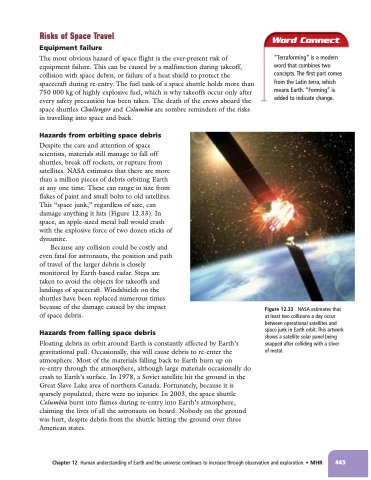Page 461 - Canadian BC Science 9
P. 461
Risks of Space Travel
Equipment failure
The most obvious hazard of space flight is the ever-present risk of equipment failure. This can be caused by a malfunction during takeoff, collision with space debris, or failure of a heat shield to protect the spacecraft during re-entry. The fuel tank of a space shuttle holds more than 750 000 kg of highly explosive fuel, which is why takeoffs occur only after every safety precaution has been taken. The death of the crews aboard the space shuttles Challenger and Columbia are sombre reminders of the risks in travelling into space and back.
Hazards from orbiting space debris
Despite the care and attention of space scientists, materials still manage to fall off shuttles, break off rockets, or rupture from satellites. NASA estimates that there are more than a million pieces of debris orbiting Earth at any one time. These can range in size from flakes of paint and small bolts to old satellites. This “space junk,” regardless of size, can damage anything it hits (Figure 12.33). In space, an apple-sized metal ball would crash with the explosive force of two dozen sticks of dynamite.
Because any collision could be costly and even fatal for astronauts, the position and path of travel of the larger debris is closely monitored by Earth-based radar. Steps are taken to avoid the objects for takeoffs and landings of spacecraft. Windshields on the shuttles have been replaced numerous times because of the damage caused by the impact of space debris.
Hazards from falling space debris
Floating debris in orbit around Earth is constantly affected by Earth’s gravitational pull. Occasionally, this will cause debris to re-enter the atmosphere. Most of the materials falling back to Earth burn up on re-entry through the atmosphere, although large materials occasionally do crash to Earth’s surface. In 1978, a Soviet satellite hit the ground in the Great Slave Lake area of northern Canada. Fortunately, because it is sparsely populated, there were no injuries. In 2003, the space shuttle Columbia burst into flames during re-entry into Earth’s atmosphere, claiming the lives of all the astronauts on board. Nobody on the ground was hurt, despite debris from the shuttle hitting the ground over three American states.
word that combines two concepts. The first part comes from the Latin terra, which means Earth. “Forming” is added to indicate change.
Word Connect
“Terraforming” is a modern
NASA estimates that at least two collisions a day occur
Figure 12.33
between operational satellites and space junk in Earth orbit. This artwork shows a satellite solar panel being snapped after colliding with a sliver of metal.
Chapter 12 Human understanding of Earth and the universe continues to increase through observation and exploration. • MHR 443


